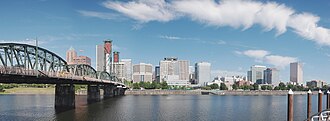
Oregon is known as the “Beaver State” due to the importance of beavers in its history and ecosystem.[1] Oregon is the ninth largest state in the U.S., covering an area of approximately 98,379 square miles (254,800 square kilometers).[2]. Oregon Population 2024. 4,227,337. Oregon currently has a growth rate of 0.89%, which ranks 22nd in the country. Oregon's 2013 population was estimated to have grown to over 4 million, making Oregon the 27th most populous state in the country.[3]
Oregon’s economy is a mix of high-tech manufacturing and services, and the agricultural and forestry sectors18. The state’s Gross Domestic Product (GDP) in 2021 was $270.12 billion.[4] The unemployment rate in November 2023 was 3.6%.[4] Oregon is among the leading states in the production of hazelnuts, peppermint, raspberries, blackberries, and loganberries. It produces large export crops of cauliflower, cranberries, hops, onions, plums, prunes, and strawberries.[5] Other important products include processors and controllers for electronic integrated circuits, machines for making semi-conductor devices, and potassium chloride.[6]
Oregon is known for its diverse collection of ecosystems, which include high snowy mountain peaks, volcanic craters, rainforests, rocky coastline, and fertile valleys. Some of the most beautiful places in Oregon include Crater Lake National Park, Columbia River Gorge National Scenic Area, Cannon Beach, and Mount Hood National Forest.
Research your ancestors on MyHeritage
History of OregonHistory of Oregon
The first Europeans to see the Oregon coast were Spanish sailors in the mid-16th century.[7] English seaman Francis Drake may have included what is now Oregon in his possession for Queen Elizabeth I in 1579.[7] However, it wasn’t until the late 18th century that European expansion in the region truly began.[8]
Oregon became the 33rd state of the United States on February 14, 1859.[9] The decision to admit Oregon to statehood was made by the House of Representatives on February 12, 1859, and two days later President James Buchanan signed the bill into law.[10]
At the outbreak of the American Civil War, Oregon raised the 1st Oregon Cavalry that was activated in 1862 and served until June 1865.[11] The state’s regular army units were sent east and replaced by volunteer units, whose primary purpose was to facilitate white settlement and suppress the Indian population.[12]
Agriculture and forestry were stimulated in the 19th century, and by the turn of the 20th century, two-thirds of the people of Oregon lived in rural areas.[7] Many workers and their families came to Oregon to work in the extractive industries of timber, mining and European-styled agriculture.[13]
The 20th century saw a shift from a rural-agrarian to an urban-industrial based economy.[13] The state’s economy faltered after World War I as farming slumped and orders to shipyards and lumber mills declined precipitously.[14]
Demographics of OregonDemographics of Oregon
The demographic distribution of Oregon population is as follows:[3]
- White: 80.69%
- Two or more races: 7.74%
- Asian: 4.44%
- Other race: 3.77%
- Black or African American: 1.85%
- Native American: 1.1%
- Native Hawaiian or Pacific Islander: 0.41%
Most common surnames in OregonMost common surnames in Oregon
Researching family history in OregonResearching family history in Oregon
The National Archives at Seattle has federal records for the states of Washington, Oregon, Idaho, and Alaska. The Oregon State Archives has an Early Oregonians Database Project that attempts to document all individuals who lived in Oregon prior to statehood and in addition has many other useful state records. The Oregon Historical Society has a research library with a website of digital collections. The Oregon Genealogical Society has a library and a full schedule of genealogy classes.
Oregon County ListOregon County List
Oregon has 36 counties.
| Baker | Benton | Clackamas | Clatsop |
| Columbia | Coos | Crook | Curry |
| Deschutes | Douglas | Gilliam | Grant |
| Harney | Hood River | Jackson | Jefferson |
| Josephine | Klamath | Lake | Lane |
| Lincoln | Linn | Malheur | Marion |
| Morrow | Multnomah | Polk | Sherman |
| Tillamook | Umatilla | Union | Wallowa |
| Wasco | Washington | Wheeler | Yamhill |
See alsoSee also
Explore more about OregonExplore more about Oregon
MyHeritage.com has 23 collections of valuable genealogical records for Oregon. These records include the Western United States, Marriage Index, 1838-2016, Oregon Newspapers, 1867-2009, Oregon, Early Oregonians, Oregon, Births and Christenings, 1868-1929, and Oregon, Marriages and Divorces. There are other important records in the Oregon Collection Catalog.
References
- ↑ 6 Oregon Nicknames and the Stories Behind Them
- ↑ Location, size, and extent - Oregon
- ↑ 3.0 3.1 Oregon Population 2024 (Demographics, Maps, Graphs)
- ↑ 4.0 4.1 Economy of Oregon Statistics and Data Trends: GDP ranking, unemployment rate, and economic growth
- ↑ Oregon - Forestry, Agriculture, Technology | Britannica
- ↑ Oregon's Top Exports 2023
- ↑ 7.0 7.1 7.2 Oregon - Exploration, Settlement, Economy | Britannica
- ↑ Oregon Country Cessation | Encyclopedia.com
- ↑ State of Oregon: Blue Book - Act of Congress admitting Oregon to the Union
- ↑ Debate Over Oregon Constitution
- ↑ Oregon Civil War History Battles Military Soldiers Army US
- ↑ Oregon's Civil War: The Troubled Legacy of Emancipation in the Pacific Northwest
- ↑ 13.0 13.1 Oregon at the Turn of the Twentieth Century
- ↑ State of Oregon: World War II - Oregon's Roaring Twenties Bring Mixed Record
- ↑ Most Common Surnames in Oregon, With Meanings

